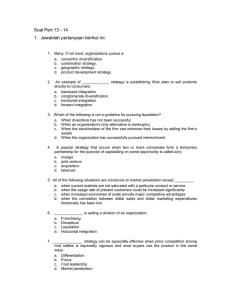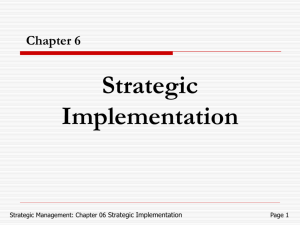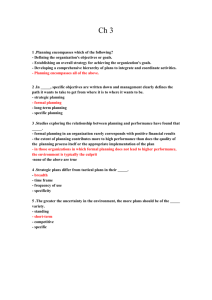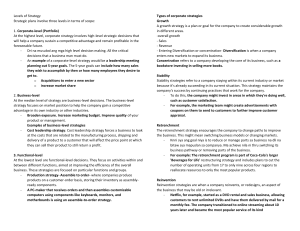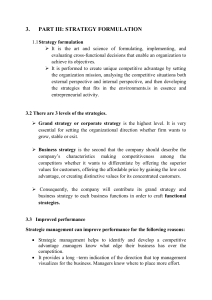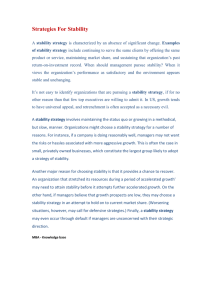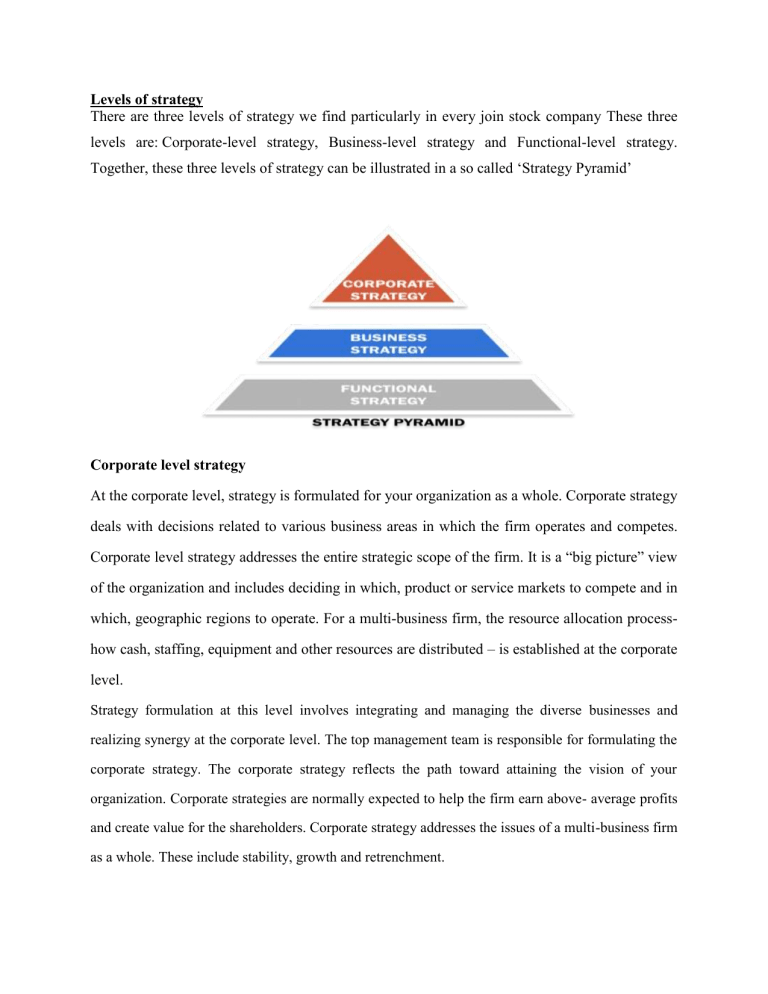
Levels of strategy There are three levels of strategy we find particularly in every join stock company These three levels are: Corporate-level strategy, Business-level strategy and Functional-level strategy. Together, these three levels of strategy can be illustrated in a so called ‘Strategy Pyramid’ Corporate level strategy At the corporate level, strategy is formulated for your organization as a whole. Corporate strategy deals with decisions related to various business areas in which the firm operates and competes. Corporate level strategy addresses the entire strategic scope of the firm. It is a “big picture” view of the organization and includes deciding in which, product or service markets to compete and in which, geographic regions to operate. For a multi-business firm, the resource allocation processhow cash, staffing, equipment and other resources are distributed – is established at the corporate level. Strategy formulation at this level involves integrating and managing the diverse businesses and realizing synergy at the corporate level. The top management team is responsible for formulating the corporate strategy. The corporate strategy reflects the path toward attaining the vision of your organization. Corporate strategies are normally expected to help the firm earn above- average profits and create value for the shareholders. Corporate strategy addresses the issues of a multi-business firm as a whole. These include stability, growth and retrenchment. For example, your firm may have four distinct lines of business operations, namely, automobiles, steel, tea, and telecom. The corporate level strategy will outline whether the organization should compete in or withdraw from each of these lines of businesses, and in which business unit, investments should be increased, in line with the vision of your firm. Corporate-level strategy is an action taken to gain a competitive advantage through the selection and management of combination of businesses competing in several industries or product markets and Coco cola, Inc., has followed the growth strategy by acquisition. It has acquired local bottling units to emerge as the market leader. Types of corporate-level strategy When you're constructing your company's corporate-level strategy, you're seeking the best ways to evenly distribute resources to serve the needs of the company to complete planned objectives. It can also help you come up with a contingency plan, you remain prepared to work under unforeseen circumstances. Let's review the different types of corporate-level strategies that you can employ: 1. Stability strategy The Stability Strategy is adopted when the organization attempts to maintain its current position and focuses only on the incremental improvement by merely changing one or more of its business operations in the perspective of customer groups, customer functions and technology alternatives, either individually or collectively. For example, a consumer electronics company focuses on providing better after-sales services to current customers and not on acquiring new customers. Why any Company Adopts Stability Strategy? Following are the reasons why a company may adopt a stability strategy: If a firm plans to consolidate its position in the industry in which it is operating. Suppose a country in which the company operates is facing a recession or slowdown. It wants to save cash rather than spend it for expansion purposes. If a company has significant debt or loans, then also it may pursue such a strategy rather than going for expansion. Following such an approach would ensure that a company has the cash to pay the interest and principal amount as well. The industry in which the firm functions have hit maturity, and there is no more scope for growth. Another scenario is when the cost of expansion is more than the gains from it. If the management is happy with the current market position and the level of profit achieved. Risk-averse management may also favor such a strategy. A company can also choose this strategy post-merger. In such a case, this strategy allows a smooth transition of the new entity before the company starts making significant changes. This strategy could help a company take a rest following a fast growth in the past few years. Such a tactic allows the company to consolidate the results and resources and plan its next moves. Family-owned businesses may decide to slow down in adverse market conditions. They do this to avoid any loss of financial control. Advantages and Disadvantages Following are the advantages of a stability strategy: Adopting this strategy does not disrupt the routine work. This strategy is less-risky unless a company faces terrible conditions. It allows the company to rethink its long-term strategies. Following are the disadvantages of the stability strategy: Such a strategy is not effective in the long run. In the long run, it could make the company irrelevant or outdated. There remains no incentive for any innovation. 2. Expansion strategy The Expansion Strategy is adopted by an organization when it attempts to achieve a high growth as compared to its past achievements. In other words, when a firm aims to grow considerably by broadening the scope of one of its business operations in the perspective of customer groups, customer functions and technology alternatives, either individually or jointly, then it follows the Expansion Strategy. The reasons for the expansion could be survival, higher profits, increased prestige, economies of scale, larger market share, social benefits, etc. The expansion strategy is adopted by those firms who have managers with a high degree of achievement and recognition. Their aim is to grow, irrespective of the risk and the hurdles coming in the way. i. Market Penetration Strategy Market penetration refers to the percentage of the population that can access your business’s products or services. If you are able to market your business to a specific market segment, you can effectively increase the number of your customers or clients. One of the best ways to increase your market penetration is to market to potential customers who are not yet committed consumers. You can do this by launching local advertising campaigns. For example, if you are running a business that provides pest control, you can launch a campaign where you offer free chemical treatments to individuals who have pets. This will increase your market share because you are offering a service that is in high demand in the market. A good example of a brand that succeeded using market penetration is Facebook. When they launched, they were available only to Harvard University students. Then, they expanded their accessibility to Stanford, Yale, and Columbia. Gradually, they accommodated all Ivy League and several schools in Boston, and then all colleges in the U.S. and Canada. Later they spread to audiences beyond students. ii. Marketing and Promotion You need to make sure that you have a solid marketing and promotional strategy in place in order to maximize your market share. You can do this by creating strong customer loyalty to your business. This can be achieved by attracting new customers through various means. One of the best ways to do this is by creating a strong customer base. By capturing a large number of new customers, you can expand your business faster because you will have more new customers to spread your business name to. One of the most effective ways to capture new customers is to create a website. A website is a great way to showcase the services that your business offers and to create the image of a professional business. If you are planning to expand abroad, you should also create a localized version of the website to have a better impact on the local customers. iii. Expansion into A New Market When a market becomes saturated with one type of product or service, there is a tendency for that market to begin to dry up. If you take a look at traditional business expansion, you may have noticed that many businesses have expanded into areas where they were previously unable to do business. This may be due to limited local market penetration, lower capital costs, higher returns, or a change in consumer preferences. Regardless of the cause of market saturation, you can use new market expansion strategies to help your business thrive. iv. Expand Your Business Abroad At some point, for businesses, the local market becomes saturated, and the only way to expand is to go abroad. This is a step that many companies are afraid of because it comes with challenges, but also many opportunities because you are able to sell your products or services to more users. You should find local partners to manage part of your business operations and especially those aspects, like HR and payroll, that can cause you to lose money and being non-compliant with the local law. All aspects that can destroy your presence in the market. In this specific situation, a PEO is the best solution for your business to outsource HR and payroll abroad, so you do not have any risk with the local laws and regulations when hiring and managing employees abroad. v. Start A Franchise One of the best strategies for business expansion includes starting a franchise, which is a process in which you open a business in a location where there is a need and people are willing to invest money and energy into it. Franchises provide a controlled environment in which you can grow your business without worrying about competitors. vi. Enter A Joint Venture or Acquisition Agreement Another strategy that can help your business is to enter into a joint venture or acquisition agreement with another business that has a larger market share. You can leverage your combined business’s strengths and obtain access to resources and markets that you would not otherwise be able to do. Your business’s success depends upon having the best strategies for business expansion. You want to expand your business to the fullest extent possible so that you can serve a greater number of consumers and provide better customer service. The key is to make strategic decisions that will yield the greatest results. You may have an idea for a business opportunity, but you should also consider expansion strategies that will allow you to realize your dream. Even if it seems like a business idea that you cannot afford, you may be surprised at how soon you can afford it. Once you have started to expand, your business will continue to grow so you can retire with some peace of mind. 3. Retrenchment strategy Retrenchment is a corporate strategy that aims to decrease the scale of operations of the company. It can also involve cutting down the expenditure of the company so that it becomes financially viable. It can involve reducing the number of product lines or businesses, withdrawing from certain geographical markets so that the company becomes financially sustainable. The Retrenchment Strategy is adopted when an organization aims at reducing its one or more business operations with the view to cut expenses and reach to a more stable financial position. Reasons to Adopt Retrenchment Strategy The reasons for adopting retrenchment strategy are as follows: 1. Poor Performance: When the performance of the company is not satisfactory and it is incurring losses then it makes sense to close down the business lines or centers which are not adding value and are acting as performance laggards in the company. 2. Threat to Survival: When the performance of the company is hampered by sudden activities in its product markets then the company may often shut down some of its operation. Mar times such a strategy is also forced by the company's shareholders. 3. Redeployment of Resources: Sometimes excellent investment opportunities exist elsewhere and the company may be forced to cut down its operations in the existing business and redeploy the resources released to more productive areas. 4. Inadequate Resources: The company may also be in the need of financial resources to sustain its existing market positions. The company may not have the requisite funds for this and may be forced to hive off unproductive areas of its business so that it may redeploy the resources. 5. For Securing Better Management and Improved Efficiency: A company sometimes expands into too many areas. This affects its operational efficiency as it becomes unmanageable. A strategy of retrenchment allows the company to become a manageable size by simplifying its product portfolio. Retrenchment Strategy Types There are three types of Retrenchment Strategies: i. Turnaround ii. Divestment iii. Liquidation 1. Turnaround Strategy A turnaround plan is a retrenchment strategy that reduces the harmful tendencies that affect the performance of the business. It is a management strategy that has the potential to revive a failing company. It reverses negative directions like declining market share, rising material costs, reduced sales, a widening debt-to-equity ratio, lower profitability, working capital concerns, negative cash flows, and numerous challenges. How businesses use this strategy differs depending on the circumstances. Dell Technologies declared in 2006 that it would employ a cost-cutting strategy by selling products directly to customers. The direct sale was unsuccessful, and the corporation suffered a significant financial loss. In 2007, Dell made a turnaround and abandoned its direct-sale strategy. Dell is currently the second-largest retailer in the world for computers. 2. Divestment Strategy A major firm that has accumulated several assets, product divisions, and departments; examine the profitability of various divisions and departments. You release them if they aren't producing the expected results. Put another way; a divestment strategy sells a section of your company, an asset, or a division. Companies use a disposal plan after a failed turnaround strategy. Diversification is a technique that businesses and companies use for a variety of reasons, including merger plans, resource creation, the existence of multiple investment plans, technology upgrades, enduring problems, mismatched assets, and negative cash flows. When a company divests, it scales back operations or sells a division to concentrate on its core challenges and utilises the proceeds to expand that division's business. Keep in mind that liquidation is not the same as divestment. In a divestiture, a company sells a non-strategic business. It receives cash for strategic investments in its core business, as opposed to a liquidation, where a company sells its unit and shuts the door. 3. Liquidation Strategy The organization’s most disagreeable option is the liquidation approach, which entails selling off its resources and ceasing all commercial operations altogether. It is the most important and final option before retrenchment strategy because it has major negative effects, including a sense of despair, lost possibilities in the future, a damaged reputation in the market, employee job loss, etc. Because there may not be any purchasers, the company using the liquidation approach may have trouble selling its assets and may not receive enough money for most of them. The extreme level of the retrenchment strategy is the liquidation approach, in which you permanently close your company and sell all of your resources. Because it might have negative effects, liquidation is the last resort for any firm with issues. Most small enterprises close their doors, and creditors, suppliers, financial institutions, trade unions, and government agencies are large businesses that don't go out of business. 4. Combination strategy The Combination Strategy means making the use of other grand strategies (stability, expansion or retrenchment) simultaneously. Simply, the combination of any grand strategy used by an organization in different businesses at the same time or in the same business at different times with an aim to improve its efficiency is called as a combination strategy. Such strategy is followed when an organization is large and complex and consists of several businesses that lie in different industries, serving different purposes. Go through the following example to have a better understanding of the combination strategy: A baby diaper manufacturing company augments its offering of diapers for the babies to have a wide range of its products (Stability) and at the same time, it also manufactures the diapers for old age people, thereby covering the other market segment (Expansion). In order to focus more on the diapers division, the company plans to shut down its baby wipes division and allocate its resources to the most profitable division (Retrenchment). In the above example, the company is following all the three grand strategies with the objective of improving its performance. The strategist has to be very careful while selecting the combination strategy because it includes the scrutiny of the environment and the challenges each business operation faces. The Combination strategy can be followed either simultaneously or in the sequence.
